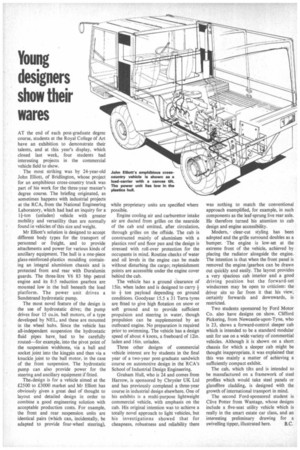Young designers show their wares
Page 52

If you've noticed an error in this article please click here to report it so we can fix it.
AT the end of each post-graduate degree course, students at the Royal College Of Art have an exhibition to demonstrate their talents, and at this year's display, which closed last week, four students had interesting projects in the commercial vehicle field to show.
The most striking was by 24-year-old John Elliott, of Bridlington, whose project for an amphibious cross-country truck was part of his work for the three-year master's degree course. The briefing originated, as sometimes happens with industrial projects at the RCA, from the National Engineering Laboratory, which had had an inquiry for a 11-ton (unladen) vehicle with greater mobility and versatility than are normally found in vehicles of this size and weight.
Mr Elliott's solution is designed to accept different body types for the transport of personnel or freight, and to provide attachments and power for various kinds of ancillary equipment. The hull is a one-piece glass-reinforced-plastics moulding containing an integral aluminium chassis and is protected front and rear with Duralumin guards. The three-litre V6 83 bhp petrol engine and its 8:5 reduction gearbox are mounted low in the hull beneath the load platform. The power unit drives a Sundstrand hydrostatic pump.
The most novel feature of the design is the use of hydrostatic drive; the pump chives four 15 cu.in. ball motors, of a type developed by NEL, and these are mounted in the wheel hubs. Since the vehicle has all-independent suspension the hydrostatic fluid pipes have, had to be carefully routed—for example, into the pivot point of the suspension wishbone, via a ball and socket joint into the kingpin and then via a knuckle joint to the ball motor, in the case of the front suspension. The hydrostatic pump can also provide power for the steering and ancillary equipment if Fated.
The,design is for a vehicle aimed at the £25130 to £3000 market and Mr Elliott has obviously given a great deal of thought to layout and detailed design in order to combine a good engineering solution with acceptable production costs. For example, the front and rear suspension units are identical pairs (which can, incidentally, be adapted to provide four-wheel steering),
while proprietary units are specified where possible.
Engine cooling air and carburettor intake air are ducted from grilles on the nearside of the cab and emitted, after circulation, through grilles on the offside. The cab is constructed mainly of aluminium with a plastics roof and floor pan and the design is stressed with roll-over protection for the occupants in mind. Routine checks of water and oil levels in the engine can be made without disturbing the cargo; replenishment points are accessible under the engine cover behind the cab.
The vehicle has a ground clearance of 15in. when laden and is designed to carry to ton payload depending on ground conditions. Goodyear 15.5 x 31 Terra tyres are fitted to give high flotation on snow or soft ground and to provide sufficient propulsion and steering in water, though propulsion can be supplemented by an outboard engine. No preparation is required prior to swimming. The vehicle has a design speed of about 4 knots, a freeboard of 12in. laden and 16in. unladen.
Three other designs of commercial vehicle interest are by students in the final year of a two-year post-graduate sandwich course on automotive design in the RCA's School of Industrial Design Engineering.
Graham Hull, who is 24 and comes from Harrow, is sponsored by Chrysler UK Ltd and has previously completed a three-year course in industrial design elsewhere. One of his exhibits is a multi-purpose lightweight commercial vehicle, with emphasis on the cab. His original intention was to achieve a totally novel approach to light vehicles, but his investigations showed that for cheapness, robustness and reliability there
was nothing to match the conventional approach exemplified, for example, in such components as the leaf-sprung live rear axle. He therefore turned his attention to cab design and engine accessibility.
Modern, • clear-cut styling has been adopted and the grille surround doubles as a bumper. • The engine is low set at the extreme front of the vehicle, achieved by placing the radiator alongside the engine. The intention is that when the front panel is removed the engine/gearbox can be drawn Out quickly and easily. The layout provides a very sPacious cab interior and a good driving position but the forward-set windscreen may be open to criticism: the driver sits so far from it that his view, certainly forwards and downwards, is restricted.
Two students sponsored by Ford Motor Co. also have designs on show. Clifford Pickering, from Newcastle-upon-Tyne, who is 23, shows a forward-control sleeper cab which is intended to be a standard modular unit for use on a wide variety of commertial vehicles. Although it is shown on a short chassis for which a sleeper cab might be thought inappropriate, it was explained that this was mainly a matter of achieving a sufficiently compact exhibit.
The cab, which tilts and is intended to be manufactured on a framework of steel profiles which would take steel panels or glassfibre cladding, is designed with the growth of international transport in mind.
The second Ford-sponsored• student is Clive Potter from Wantage, whose designs include a five-seat utility vehicle which is really in the smart estate car class, and an interesting preliminary drawing for a
swivelling tipper, illustrated here. B.C.




































































































